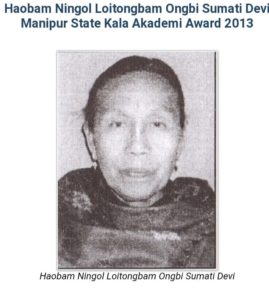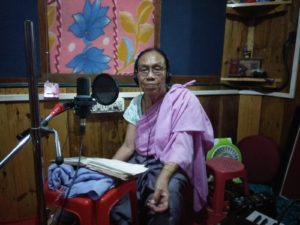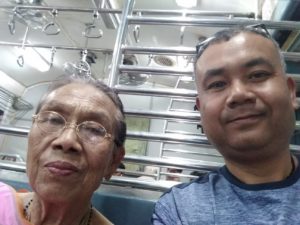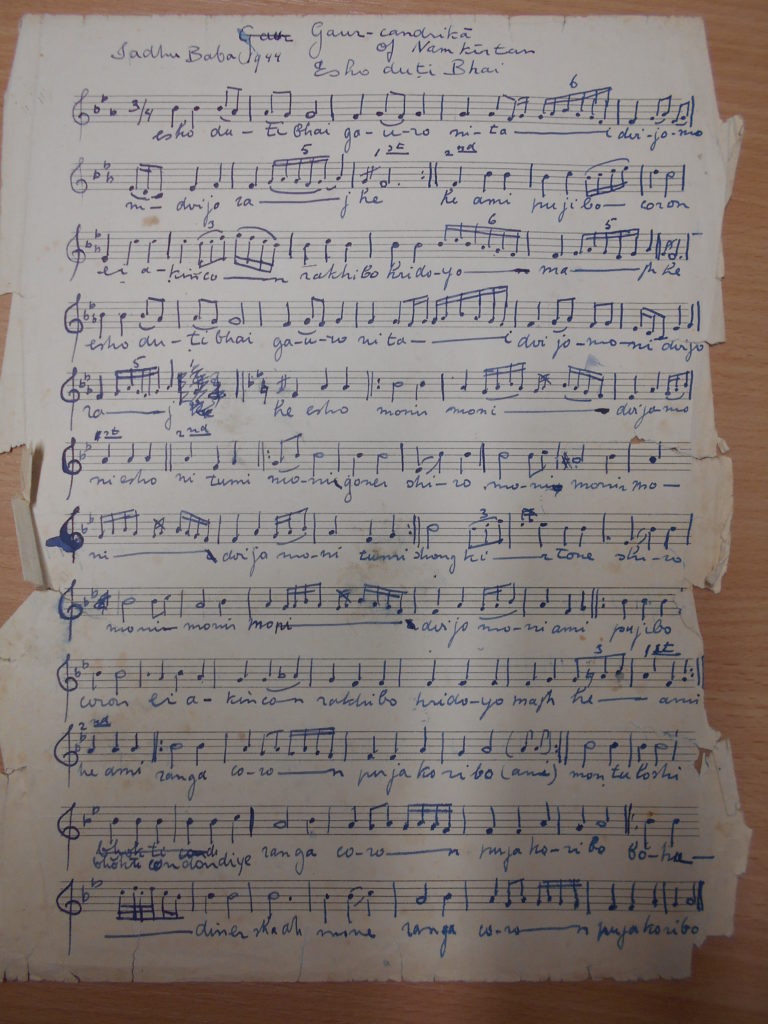
Manoharsai from Sumati Devi of Manipur
It is through Akhu Chingambam that I got connected with his bandmate Sunil Loitongbam and through Sunil, with the voice of his mother, Sumati Devi. Had Arnold Bake visited Manipur in 1956, he would probably have met Sumati Devi’s gurus, because she was a teenager then. Who knows? Like fifteen-year-old Chitralekha Choudhury in Santiniketan, maybe he would have met and recorded Sumati Devi too with his reel-to-reel recorder?
Born in 1940, Sumati Devi (Srimati Haobam Ningol Loitongbam Ongbi Sumati Devi) of Nagamapal Kangjabi Leirak, Imphal, Manipur, is one of the few women who still sing the Monoharsai or Monorsai style of kirtan, which is a dying art form of the state. However, she has worked all her life to revive this art.

Sumati Devi received her initial training in music as a child from L. Ibopishal Singh. Later she studied north Indian classical music and received her Sangit Visharad degree from the Bhatkhande School in Lucknow. She went on to become an approved singer of All India Radio, Imphal. It was following her marriage with the tabla guru Menjor Singh that her career as a kirtan singer took off, as she began studying with her father-in-law, the master of Manoharsai, L. Ibomcha Singh. Sumati Devi also took lessons from Gurumayum Robindro Sharma, H. Modhu Sharma and Gurumayum Bhagendra Sharma. All her life Sumati Devi has performed in numerous festivals and ceremonies across her state. For her contribution to Manoharsai kirtan, Sumati Devi has been awarded the Manipur State Kala Akademi Award.
Conversation with Sunil on the phone about his mother on 3 December 2021
Though in her eighties and frail now, Sumati Devi still sings the Manoharsai with grace and beauty. I am grateful to her musician son, Sunil, for sharing her songs, photos and their knowledge with The Travelling Archive. As I was telling Akhu and Sunil, my initial curiosity was about the journey of the kirtan of Bengal to Manipur and its flowering into a song of its own in another soil. I was thinking of traces—what remain from the past and what get added over time, for the future.
In response to my questions, Sunil recorded this song in Bangla, what he calls the ‘Gourchandrika’, song in praise of Gouranga Mahaprabhu, taking his mother to his own studio ‘Hayum Lab’ in Imphal in late 2021.


Interestingly, in 1944 Arnold Bake had notated several Gourchadrikas which he had learned from his teacher, Sadhu Baba. Oliver Weeks had sung the song notated below, while Nirmalendu Mitra Thakur had sung the same song as he knew it when we went to Maindadal for the third time in January 2016.

Arnold Bake’s kirtan notations are archived at the School of Oriental and African Studies in London. I looked at them and took some photographs while working at the library in 2015. This is one page from the collection. with a Gourachandrika
Oliver Weeks sings from Bake’s Gourachandrika notation. He recorded himself in London in February 2016.
Nirmalendu Mitra Thakur sings the same Gourachandrika as he knows it, as he had learned from Gobindagopal Mitra Thakur. Recorded by Sukanta Majumdar for The Travelling Archive in Mainadal on 20 January 2016.
Around 2016-17, Sunil had recorded his mother singing the ‘Murli Horon’, a song in nine parts, which is a story from the life and divine love of Radha and Krishna; murli referring to Lord Sri Krishna’s bewitching flute and horon meaning to steal; it is the story of the flute of Krishna which steals the heart of Radha.
Sunil had recorded his mother in his studio, and the accompanying khol player was Bhramacharimayum Gopiromon Sharma. Sunil wrote to me: ‘She learned all the above songs from her late guru Gurumayum Bhagendra Sharma. According to her, the lyrics are translations from Bengali texts and her guru just taught them his compositions and she is not quite aware as to how and from where it was compiled by him. It’s more like in the mode of guru shishya parampara [the oral tradition of the guru passing the song to the pupil], the way they have learned these songs over a period of several years. I have not myself quite dug into this form of music in detail till now; further research is needed in terms of highlighting and understanding this dying art form known as monorshai– a kirtan style of music prevalent in Manipur.’
- Manipur Univisited
- In Search of Nabadwip Brojobashi
- Nirmalendu Mitra Thakur Explains Bake’s Kirtan Recordings, 2021
- Found Film: Janmashtami and Nandotsav in Mainadal, 1994
- Kirtaniya Seema Acharya Listens to Olly
- Olly Weeks Reads Bake’s Kirtan Notation
- In Mongoldihi, November 2015
- The Niyomsheba Songs, October 2014
- First Time in Mainadal, August 2014
